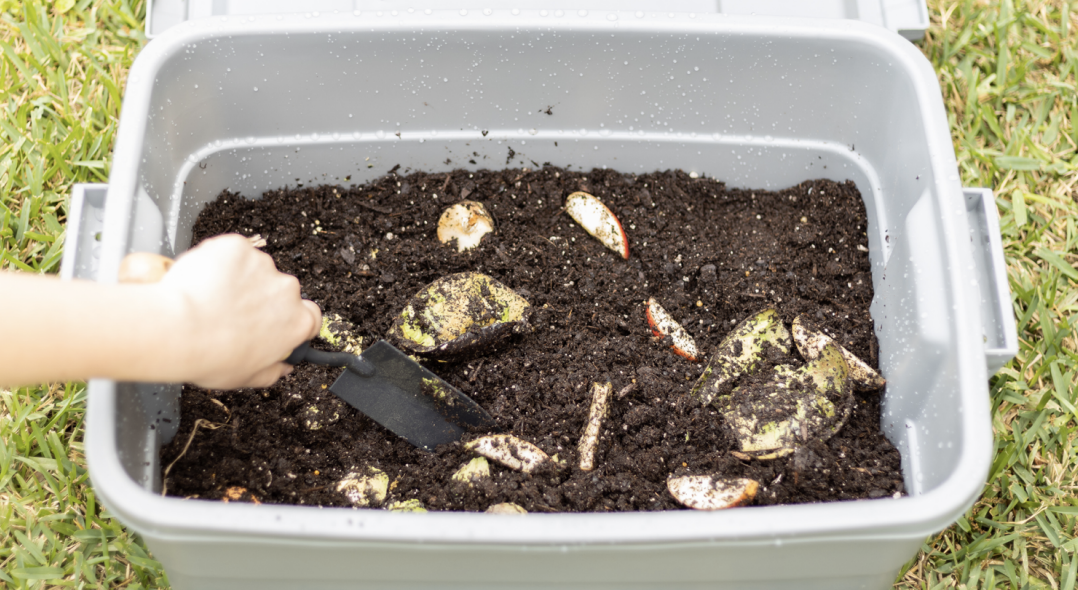Spring comes with bumblebees, blooms and — plastic bins. Aerated static pile composting is an easy and effective way to reduce waste in our daily lives.
Food scraps and waste make up approximately 30% of the nation’s trash overall, according to the U.S. Environmental Protection Agency, or EPA. To combat growing waste, basic items such as browns, greens and water are combined in the bin and stored in the sun to allow decomposition. “Browns” include dead leaves, branches and twigs, while “greens” include grass clippings, vegetable waste, fruit scraps and coffee grounds.
Meat and eggs are not recommended to drop in the compost bin as their complex carbohydrate structure makes these proteins slow to decompose. There is a high risk of bacteria contamination in meats, which thrive in a compost bin’s warm, humid environment.
Constructing a cheap bin is a perfect spring activity for an environmentally conscious, broke college student like myself. The catch is your compost may not be ready to use for anywhere from six months to two years. To make a difference, patience and persistence are paramount.
To begin the process, I grabbed an 18-gallon plastic tub and drilled small holes on the lid, sides and bottom of the tub to allow for circulation within the concoction. I added browns, then greens and finally watered the mix and put the bin in a dry and shady spot, put the lid on and now can add scraps regularly.
Composting enriches soil by keeping moisture in and pests and plant diseases out, according to the EPA. In a warm environment, a cover is needed to trap moisture, while in a cool environment, the center of the bin will remain warm. Placing the bin inside will counteract stagnant heat because the goal is to keep warmth circulating.
Being a forgetful person makes this process a challenge, so I found it helpful to set a reminder on my phone to stir my compost. Heat is a necessary factor in determining the decomposition status of waste. Decomposition occurs most rapidly during the thermophilic stage of composting, 104-140o F, according to the Cornell Waste Management Institute. The process kills pathogens, larvae and other microorganisms. It is recommended to stir or turn your pile every three to seven days. Stirring too often can cause a disruption of the fungus and could prevent the contents from heating up.
Stirring helps to avoid potential hazards including heat generated from microbial activity can cause fires, according to the International Association of Certified Home Inspectors, or IACHI. It is important to regulate the temperature of your pile to avoid spontaneous combustion.
Health hazards, such as Aspergillosis, can occur when inhaling plant matter fumes, according to the IACHI. Extensive exposure to the contents in a compost pile can potentially cause diseases, so it’s vital to use protection including gloves to protect your hands and a mask that blocks breathing in spores. Long sleeves and pants will help avoid cuts and tetanus, which may enter your bloodstream through soil contents.
Downstream water quality is improved by retaining pollutants including heavy metals and pesticides due to composting, according to the EPA. Compost and composted products help reduce water pollution with its ample water-holding abilities. It reduces the need for irrigation due to water infiltration and soil characteristics. Practicing safe composting is a direct method to reduce greenhouse gas emissions and recycle in a unique way.
If you are looking for a fun and effective activity this spring, give this at-home practice a try. The war over waste will be effectively fought, and, maybe, you too will have some fun.
COMPOSTING FAST FACTS
Temperature Range for Composting:
Optimal temperature range for good composting is 130-150o F.
Effective temperatures aid food decomposition and kill harmful pathogens and micro-organisms in the soil.
Warning – No Proteins:
Proteins should not be added into compost bins. The EPA states meat and animal products cause odor problems and attract unwanted pests like rodents and flies. Proteins take much longer to decompose than simpler material such as plant waste.
Mask Up:
Use a 3M filtration gardening mask to avoid Aspergillosis and other lung diseases caused by inhaling fumes.
Where Does My Bin Go?
Place your compost bin in a sunny and dry area of your yard to increase the heat aiding in decomposition.
Indoor options include bins such as:
- Electric composters that can be stored on your countertop
- Aerobic bins that require oxygen for decomposition
- Anaerobic bins that do not require oxygen for decomposition
- Worm bins





















